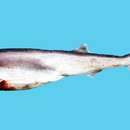Biology
provided by Arkive
Despite being a rather small and slender shark, the strong swimming sharpnose sevengill shark is a voracious predator that is most active during the night (2) (4). It has a varied diet, feeding on a range of marine invertebrates, such as shrimp, lobsters, squid and cuttlefish, as well as small bony fish such as hake, small sharks and rays (2). This shark itself is thought to be preyed on by larger sharks (2). Although this shark is said to be quick to bite when captured, it is too small to be dangerous to humans (4).
The sharpnose sevengill shark is an ovoviviparous species, a method of reproduction in which the young develop within eggs that remain inside the body until they hatch. Females give birth to between 9 and 20 young in a litter (4), each one measuring around 25 centimetres long (2)
Conservation
provided by Arkive
There are not known to be any conservation measures in place for the sharpnose sevengill shark (1).
Description
provided by Arkive
The large, florescent green eyes of this slender shark may be its most noticeable feature as it moves silently though the ocean depths. As its name describes, this shark has a narrow, pointed head, a long, narrow mouth and seven gill slits down each side; most sharks have only five (2). The slim body is brownish-grey to olive on the upper surface, and paler on the underside, and it has only one small dorsal fin (2), the fin situated on the shark's back that helps prevent it from rolling in the water (3). Juvenile sharpnose sevengill sharks differ a little in appearance from adults, having dark blotches on the lower sides, and dark tips to the dorsal and tail fins (2).
Habitat
provided by Arkive
The sharpnose sevengill shark is found near the sea bottom, usually at depths between 27 and 720 metres, although occasionally is may also be found in shallower coastal waters, or in water as deep as 1,000 metres (4))
Range
provided by Arkive
This shark has a very wide distribution, occurring in tropical and temperate seas worldwide (4), except the eastern north Pacific (1), although nowhere is it believed to be common (2).
Status
provided by Arkive
Classified as Near Threatened (NT) on the IUCN Red List (1).
Threats
provided by Arkive
Bycatch in fisheries is thought to be the greatest threat to the sharpnose sevengill shark, and may have caused populations to decline in areas where deepwater fisheries have been in operation for many years (1). It is captured in bottom trawls and by longlines, as fishermen target other, more commercially important, bottom-dwelling species, and is then eaten by humans or used for fishmeal (1). Although not considered to be threatened with extinction, an increase in fishing effort in deepwater regions inhabited by the sharpnose sevengill shark could have a detrimental affect on this slender species (1).

